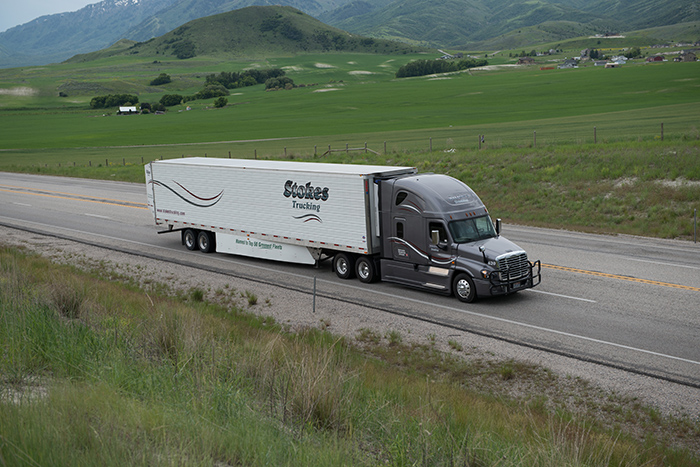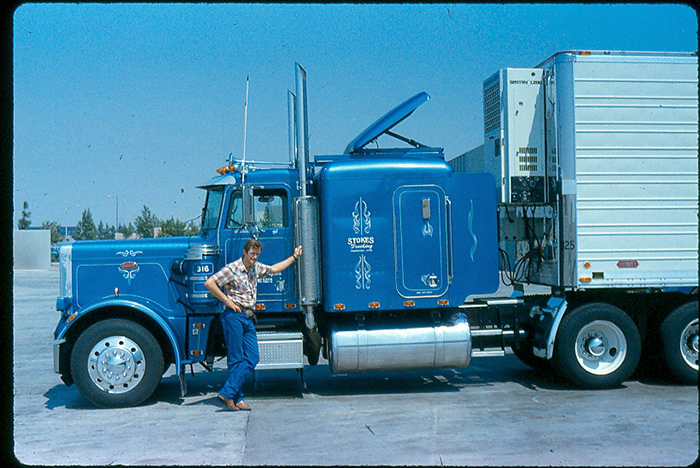Renovated Airstreams, trailers, and camper vans have mixed nostalgic wanderlust with modern conveniences, making many Millennials dream of selling their belongings and hitting the open road. The freedom of going wherever, whenever, is enticing—especially when these adventures are documented with hashtags and validated with likes, comments, and virality.
However, Millennial minimalists are not the first ones to hit the road—not even close. First there were the pioneers on covered wagons, then the railroaders, and still today there is a large community of people who spend their lives driving, almost 24/7, without any pomp and circumstance.
Enter truckers—the opposite of hipster #vanlife, and the unsung heroes that keep our grocery stores stocked and our businesses running.
One of these hidden heroes is Val Stokes, founder and owner of Stokes Trucking. As a 17-year-old in the early 1970s, he worked at a local truck stop, the Crossroads, in his hometown of Tremonton, Utah, and felt the wanderlust bug bite him.
Val loved watching people come and go. “I’d see the truckers pull into the Crossroads, get their fuel, go into the café and have dinner, then get in their truck and head off. I thought, ‘Geez, I wonder where he’ll be tomorrow.’ All my life, I’ve loved seeing what’s over the next hill. So I just thought it would be fun to drive for a living.”
In 1978, he began driving trucks for others. But the following year, he persuaded his father-in-law to cosign on a loan that would finance his first truck. Leaving behind his wife and one-year-old son, Val began to drive five or six days a week, 600 or 700 miles a day, at the then-national interstate speed limit of 55 miles per hour.
With a trailer full of canned soup, or dairy products, or bananas, or pharmaceutical supplies, or baking flour, or even bowling balls, Val would head to a new destination each week: maybe Las Vegas, Los Angeles, the Bay Area, Wisconsin, South Dakota—anywhere. All without any form of GPS.
“I had an atlas,” says Val. “A good old Rand McNally. I had a briefcase full of city maps, like Chicago, LA, San Francisco. You could buy those at truck stops readily. Anytime I’d go to a city I’d never been before, I’d stop on the outskirts of town and buy myself a map.”
And if he needed to call a customer to verify directions, he’d have to stop at a truck stop and use the payphone.
Still to this day, Val knows not only how to navigate across the country on the interstate, but how far all the cities are from one another.

Photo by Paul Waldron
“From right here in Tremonton, it’s 110 miles to Evanston, Wyoming,” he recalls from his inner map. “403 miles across Wyoming, 456 across Nebraska, and 310 across Iowa—and you’re in Illinois.”
On his cross-country treks, he would tune into a good AM or FM station or listen to one of his cassette tapes. He would also check out books on tape at one truck stop that could be returned at another, like an interlibrary loan.
Truck stops were and are central to life on the road. At truck stops, truckers refuel both their bellies and their trucks, take showers, and park for the night so they can snooze in their sleepers. Nowadays, like everything else, many mom-and-pop truck stops have been taken over by large chains.
When Val would get hungry—the ice in his cooler from home melted and the homemade sandwiches long gone—he’d stop at a truck-stop café, where he consumed “good, home-cooked meals.” (Unlike today, his early trucks lacked amenities such as a microwave and refrigerator.)
“You could get anything,” Val says. “Omelets, chicken-fried steaks, mashed potatoes. Any kind of breakfast, lunch. A lot of times they’d have a lunch special. Most truck-stop cafés would have a special at night. But you could get anything from spaghetti or chicken parmesan to a patty melt or a steak.”
After eating, he’d head back out to deliver his load until he needed to stop again. Truckers are only allowed to drive for eleven hours at a time, meaning that if a trucker hits his or her limit fifteen minutes outside of a big town, they have to stop on the road and wait until they can drive again. In the early days, trucker logs were on paper, and a creative mind could get around the eleven-hour limit easily. Today’s trucks, with their electronic logs, are not so forgiving.
Despite the daily grind, Val enjoyed seeing the sights as he drove. One of his favorite routes traversed through the Upper Midwest.
“I liked the Upper Midwest in about May, when the corn’s about that tall”—Val’s hand demonstrates about three or four feet off the ground—“and everything’s green. You can look at the corn rows over the rolling hills and it wasn’t too hot and humid yet. It was beautiful.”
He also loved driving to California, where you could see relics from the 1940s, 1950s, and 1960s. Now, the desert drive is bumper-to-bumper from Vegas to LA. He misses the days when you could pull a big truck onto the Vegas Strip, right up to a hotel casino, and indulge in the $1.99 buffet.
The increase of traffic is one of the biggest changes Val has seen through the years. That and gas prices—when he bought his first truck in 1979, diesel fuel was just 35 cents per gallon.
40-plus years, a brand-new office building, and forty trucks in the fleet later, Val only takes a load when one of his drivers is sick. But he’s still proud of being a trucker.
“It’s a great profession,” he says. “It’s one that’s severely underappreciated, and that’s kind of a sign that we do our jobs so well. If we weren’t doing our jobs so well, we’d get a lot more attention.”
—Ashley Evans

